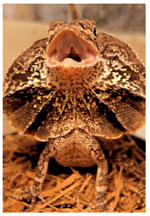
Frilled lizards and Chukwallas

You may wonder whether the creatures mentioned in the headline really
exist or are some fantasy names. But, surprise, surprise, they do exist
and are in fact, members of the large reptile family. Before we proceed
any further about these two creatures, let's briefly check out as to
what reptiles are, because, more often than not, the mention of reptiles
brings to mind only snakes, for many people.
So, what is a reptile? Well, there are about 6,000 (or more)
different kinds of reptiles that have been divided into groups. They
include around 20 crocodiles and alligators, 600 tortoises, terrapins
and turtles, 2,500 lizards (which includes the two creatures mentioned
above) and a small number of snakes.
And, would you believe that one particular group of reptile has just
one animal - a living fossil called the tuatara? Reptiles are mostly
found in the warmer parts of the world, and they may be smaller than one
of your fingers or many times as big as you are! We'll give you more
information on reptiles in a future issue. Now let's check out the above
mentioned two interesting creatures, from among these reptiles.
What Frilled lizards look like
Also known as Cloaked lizards, these are rather small lizards,
usually between 70-95 cm in length from head to tail. As the tail alone
measures upto 65 cm, you can imagine the actual size of the lizards.
These creatures are not harmful or poisonous to other animals, and are
preyed upon by birds such as eagles and owls, snakes and other larger
lizards.

Their skin colours may be orange or red and usually matches the land
or tree they live on. This generally helps them to stay camouflaged from
such predators, but this may not work all the time. It is then, (and
also to communicate) that the lizards use their 'frill' around the neck.
Covered with scales, the frill normally lies in folds around the neck
area. But, when confronted by an enemy, the lizards turn themselves into
frightful monsters with the help of the frill.
They open their mouth wide and the neck frill too spreads out like an
umbrella, giving them a frightful appearance. Then, they hiss loudly and
thrash the tail hard on the ground, but it's all a big bluff. However,
if necessary, the lizards do bite their enemies with their strong teeth.
They belong to the family of lizards called 'dragons'.
The males which are more brightly coloured are extremely territorial.
Frilled lizards are considered unique creatures and have even been
chosen as the reptile emblem of Australia.
Behaviour and eating habits
Frilled lizards are carnivores and hunt insects such as cicadas,
spiders, ants, small lizards and even mammals.

They have good eyesight to locate their food. They are active during
the day, not only hunting for food, but also absorbing the energy from
the sun which allows them to feed and run quickly when faced with
danger.
As frilled lizards can move very fast using only their hind legs,
they are also called 'bicycle lizards'.They have a lifespan of about 20
years. The female lays around 20-23 eggs in the ground.
When the eggs hatch about five months later, the baby lizards are
left to fend for themselves. They spend 90 per cent of their time upon
trees to regulate their body temperature.
Habitat
They bask in the sunshine in the early morning and hide in the shade
of the tree canopy most of the time.
They grab the food and hurry back to the trees.
Frilled lizards live in dry forests, and Savanna woodlands in the
northern parts of Australia and also in Southern New Guinea. |


